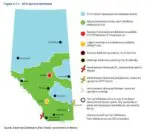Electricity Transmission and Distribution Costs in Alberta

The Alberta Electric System Operator (AESO), which operates the electrical network of Alberta, has recently published a report on the delivery costs of electricity in the province. The report covers all major sectors in Alberta and explains the delivery cost trends, as well as the key drivers behind them.
READ MORE: How Distribution and Transmission Costs Will Increase in Alberta
The report also highlights the cost-saving ways of reducing it over the coming years. This blog attempts to deconstruct, simplify, and summarize this report, especially for residential and commercial customers, which account for approximately 13% and 20% of the total electricity consumption respectively. By the end of this blog, we hope to have provided you with a better understanding of the delivery charge components of your electricity bill.
Alberta is majorly serviced by six distribution companies with defined service territories. These are:
- ATCO Electric (North Alberta and intertie between Alberta and Saskatchewan).
- EPCOR Distribution and Transmission (exclusively for Edmonton).
- Enmax Power (exclusively for Calgary).
- City of Red Deer (exclusively for Red Deer).
- City of Lethbridge (exclusively for Lethbridge).
- Fortis Alberta (for most of Southern Alberta).
Inter-province connections are operated by different entities:
- AltaLink (between Alberta and British Columbia).
- Enbridge (between Alberta and Montana).
- ATCO Electric (between Alberta and Saskatechewan).
Drivers of Distribution and Transmission charges (D&T costs)
Each distribution company mentioned above has set rates for various customer classes, which are largely residential, commercial, and industrial and farm. Each of these categories vary based on load consumption by each category in that region. In general, the consumer category with the highest volume of electricity consumption pays the lowest delivered cost of electricity on a per unit basis ($/MWh).
The energy charge component of a utility bill is based on supply and demand, commodity prices, and carbon policy, and thus, are more volatile. This is not the case with delivery costs (also known as distribution & transmission costs or simply D&T costs). Delivery costs in Alberta utility bills have seen an upsurge in the last decade due to infrastructure expansion and integration to the existing ones.
In case you don’t know, the delivery cost is based on a Return-On and a Return-Of system, infrastructure implementation costs, and operating costs.
Components of D&T charges and cost trends
Distribution and transmission charges are often considered a single entity but are actually two different components of delivery costs. The distribution charge varies with location and consumption, and includes the cost to bring electricity from the transmission system to a site. Transmission charges, on the other hand, is based on the energy consumption in a billing period. It also includes the cost incurred to ensure the safe and reliable operation of the transmission grid.
In addition to these two components, the delivery cost includes administrative charges and other expenses. Administrative charges cover the cost for the retailer to provide customer service and other expenses. For more details, check out our breakdown of energy bills in Alberta.
Rate of consumption also affects delivery costs. These charges are usually higher for small consumers and decrease for higher loads of consumption. Proportionally, residential customers pay more delivery costs for electricity they consume.
The location and remoteness of a site can also affect electricity delivery costs in Alberta. This means that urban areas cost less than rural ones. Hence, ATCO customers and Fortis Alberta customers pay more for their delivery costs than EPCOR and Enmax residential or commercial customers.
ATCO’s distribution costs for a typical residential customer are higher than the same customer would experience in other service territories. Because of relatively long distances between customers, the relatively small number of customers in the service territory, and the complexities of the terrain in northern Alberta. The delivery cost of electricity for commercial customers is weighted to energy costs. Small commercial customers pay higher transmission expenses than their medium and large commercial counterparts.
DFO service territories: This infographic taken from the AESO website enables us to see which distribution and transmission company covers each region in Alberta.

Delivery cost trends over time in Alberta
To maintain a reliable and congestion-free system, new infrastructure has been built in the past decade, due to which transmission and distribution costs have been increasing at a rate higher than inflation. These charges have significantly increased for residential customers across the service providers between 7 and 11%.
For the commercial sector, the rising trend is steeper for small businesses than medium or large commercial. Commercial customers, in general, have experienced annual delivery cost increases between 10 and 18.3%.
To assess what changes in the delivery costs of any consumer category, the costs can be classified as:
- Fixed costs (standard charge regardless of the energy consumption).
- Demand charges (based on peak consumption during billing period).
- Variable costs (based on total consumption in a billing period).
Residential customers do not have a demand charge included in their tariff, unlike other consumers. Based on this classification, fixed cost components have increased for residential customers whereas demand and variable charges have gone up for small-medium and large commercial, respectively.
Self-supply is becoming economically more attractive
The micro-generation regulation in Alberta allows Albertans to meet their own electricity needs by generating electricity from renewable or alternative energy sources on-site. With distribution and transmission costs going up, and on-site generation costs decreasing, many people are starting to see micro-generation as an option to reduce overall energy bills.
Under Micro-generation Regulation, excess electricity from self-supply producers generate credits for what they feed to the grid. Doing this can substantially reduce the variable cost associated with the delivery charge, as metered volumes are reduced, and fixed costs that are based on peak load may be reduced depending on the resulting consumption for grid supply subsequent to the installation of on-site generation.
In Alberta, a large proportion of small-scale consumers can install solar photovoltaic (PV) systems or natural gas generators (to enable on-site power generation). Of these two, solar PV seems more feasible for small scale customers. It can also be easily integrated into many buildings and has low maintenance burden.
The cost of PV has drastically decreased over the past decade from USD 6.11/ Watt in 2009 to USD 2.13/ Watt in 2019, as cited by the AESO report.
If on-site generation costs remain at this level or decline further, the self-generation option may become more lucrative than procuring from the grid. When a customer installs solar generators at a large enough size, they can generate surplus electricity in the solar-intensive summer months, which provides revenue to offset electricity consumption in the future.
Another factor that is important for optimal generation, and consequently sooner returns, is the right way of installation to ensure optimal power generation. For Alberta, it is 20-degree tilt angle and south-facing PV panels.
Since small and medium commercial customers receive electricity at a lower cost than residential customers, adopting solar PV may not be financially beneficial. However, if solar PV costs continue to decline while distribution and transmission costs increase, the economics of self-supply for small commercial customers could improve enough to make solar PV a profitable investment.
Natural gas is considered a financially viable option for large commercial and industrial consumers. Large commercial customers have enough electrical capacity to consider matching their load with on-site natural gas-fired generation. While the capital cost of natural gas has remained constant in the past decade, its operation costs have come down because of falling natural gas rates.
Fortis, ATCO and ENMAX’s tariffs each contain a customer class specifically for a distribution-connected generation. The intention of these classes is to reflect charges and credits for independent generators, but they may be applicable where customer generation exceeds customer load.
Customers can deliver surplus electricity and receive credit for forgone transmission costs, which can provide a supplemental source of revenue for a distribution-connected generator. At present, residential rooftop solar could only be competitive in ATCO’s service territory, if a very low discount rate is applied.
Looking on how to reduce your utility bills? Visit EnergyRates.ca, a free website in Canada for an unbiased energy cost comparison. Residential, small business, commercial, large commercial and industrial electricity and natural gas consumers can all use our tool to compare the best energy rates in their areas. Using EnergyRates.ca is easy – all you need to do is fill in the form above to get started.
READ MORE:











